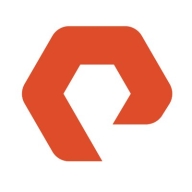


Find out in this report how the two Software Defined Storage (SDS) solutions compare in terms of features, pricing, service and support, easy of deployment, and ROI.
It does not require much management once you set up correctly, so it saves time, allowing an admin to focus on other work.
Their technical support has been perfect lately, so I would give it a 10.
I would rate them an eight out of ten.
The support is done through email and is not that great, making it a very problematic area I've been dealing with for over four years.
There are between 5 and 10,000 people using it in our organization.
Pure Storage FlashBlade is scalable.
It wouldn't help with outages either; the scaling is manual, and there are no processes we've used to automate that for unexpected scenarios.
In case there is any issue with any blade, the data is moved to another.
Technical support definitely needs significant improvement.
One way Pure Storage FlashBlade can be improved is by having more compatibility between the FlashArray and FlashBlade.
Its configuration should be easier.
My opinion is that support is generally very good. There are instances where they take longer to respond or resolve issues, especially when customers have urgent needs, but ultimately, resolution is achieved.
It would be nice to see technology supporting the Elastic Fabric Adapter on Amazon AWS, therefore getting RDMA technology for more low-latency connections.
Regarding pricing, it is okay; we needed exactly this in size, and the price was a lot lower than competitors, making it good for us.
The pricing of Pure Storage FlashBlade is expensive compared to other products I used from other companies in the past, but one benefit is that they have built-in ransomware protection.
Pure Storage FlashBlade's scalability is one of the most valuable features, and importantly, it always works, allowing for seamless upgrades.
The best features of Pure Storage FlashBlade include better throughput and better performance.
We can plug in many blades, and we can have data up to one terabyte.
The granular ability to divide up the performance and the amount of storage you want is really fantastic.


| Company Size | Count |
|---|---|
| Small Business | 11 |
| Midsize Enterprise | 11 |
| Large Enterprise | 21 |
| Company Size | Count |
|---|---|
| Small Business | 8 |
| Midsize Enterprise | 11 |
| Large Enterprise | 53 |
| Company Size | Count |
|---|---|
| Small Business | 6 |
| Large Enterprise | 1 |
FlashBlade is the industry’s most advanced scale-out storage for unstructured data, powered by a modern, massively parallel architecture to consolidate complex data silos (like backup appliances and data lakes) and accelerate tomorrow’s discoveries and insights.
NetApp Cloud Volumes ONTAP is an efficient storage management solution for managing and storing data in the cloud. It offers seamless integration with cloud providers, advanced data replication capabilities, and high data protection. With reliable performance, it is ideal for industries like healthcare and finance.
StorPool is intelligent storage software that runs on standard servers and builds scalable, high-performance storage system out of these servers (software-defined storage). It focuses on the block-level storage and excels at it. It is incredibly flexible and can be deployed in both converged setups (on compute nodes, alongside VMs and applications) or on separate storage nodes.
StorPool has advanced fully-distributed architecture and is arguably the fastest and most efficient block-storage software on the market today. It is the best storage system when building a cloud.
We monitor all Software Defined Storage (SDS) reviews to prevent fraudulent reviews and keep review quality high. We do not post reviews by company employees or direct competitors. We validate each review for authenticity via cross-reference with LinkedIn, and personal follow-up with the reviewer when necessary.